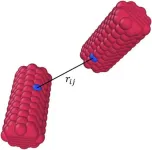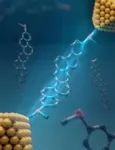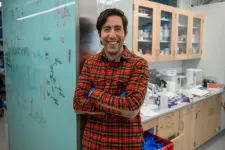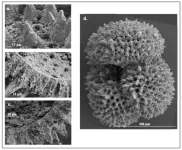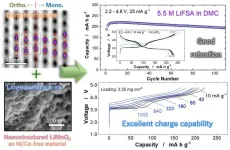(Press-News.org) Simulating particles is a relatively simple task when those particles are spherical. In the real world, however, most particles are not perfect spheres but take on irregular and varying shapes and sizes. Simulating these particles becomes a much more challenging and time-consuming task.
The ability to simulate particles is critical to understanding how they behave. For example, microplastics are a new form of pollution as plastic waste has increased drastically and uncontrollably decays in the environment by either mechanical means or UV degradation. These very tiny particles are now found nearly everywhere in the world. To be able to remedy this environmental crisis, it is important to understand more about these particles and how they behave.
In an effort to combat this challenge, researchers at the University of Illinois Urbana-Champaign have trained neural networks to predict interactions between irregularly shaped particles to accelerate molecular dynamics simulations. With this method, simulations can be done up to 23 times faster compared to traditional simulation methods and can be applied to any irregular shape with sufficient training data.
“Microplastics are now present everywhere in the environment and most of them are not spheres, they are very heterogeneous, and they have corners and edges. Tackling the problem of how they behave in the environment requires us to develop new methods, finding ways to simulate them faster, cheaper and more efficiently,” says Antonia Statt, professor of materials science and engineering.
Spheres are easy to simulate because the only parameter needed to determine how two particles interact is the distance between the centers each sphere. Moving from a sphere to more complicated shapes—like cubes or cylinders—requires knowing not only how far away two particles are from one another, but also the angles and the relative positions of each particle. The traditional method of simulating cubes, for example, involves building the cube out of many little spheres.
“It’s a very roundabout way of describing a cube, to tessellate it with small spheres,” Statt explains. “It’s also expensive because you have to calculate the interactions of all the little spheres with each other. To bypass that, we used machine learning—a feed forward neural net—which is a fancy way of saying, ‘let’s fit a complicated function that we don’t know.’ And neural nets are really good at that. If you provide them with enough data, they can fit anything you like.”
Using this method, all the distances between the little spheres don’t need to be calculated individually. Only the cube center-to-center distance and its relative orientation is needed, making it much easier and faster. Further, this method is as accurate as traditional methods. It cannot be more accurate since it is trained on data produced from traditional methods, but it can be more efficient.
In the future, Statt would like to be able to simulate more complicated irregular shapes as well as mixtures of different shapes, like a cube and a cylinder rather than two cubes. “We will have to learn all the individual interactions, but the method is general enough that we will be able to do that,” she says.
This research, “Molecular dynamics simulations of anisotropic particles accelerated by neural-net predicted interactions,” was recently published in The Journal of Chemical Physics and was selected for the 2024 JCP Emerging Investigators Special Collection. It also features on the cover of this issue of JCP.
Antonia Statt is also an affiliate of the Materials Research Laboratory, the department of chemical and biomolecular engineering and the Beckman Institute for Advanced Science and Technology at Illinois.
Other contributors to this work include B. Ruşen Argun (department of mechanical engineering, Illinois) and Yu Fu (department of physics, Illinois).
This research was funded by the Molecule Maker Lab Institute (MMLI): An AI Research Institutes program supported by the National Science Foundation.
END
Using machine learning to speed up simulations of irregularly shaped particles
2024-08-26
ELSE PRESS RELEASES FROM THIS DATE:
Ochsner Digital Medicine teams up with AmeriHealth Caritas Louisiana to improve treatment of hypertension, Type 2 diabetes
2024-08-26
New Orleans, LA. – Ochsner Digital Medicine has teamed up with AmeriHealth Caritas Louisiana to offer digital medicine services to the health plan’s members. Utilizing remote patient management (RPM), Ochsner Digital Medicine and AmeriHealth Caritas Louisiana will work together to help members with certain chronic conditions better manage their health and improve their quality of life.
AmeriHealth Caritas Louisiana, part of the AmeriHealth Caritas Family of Companies, is a Healthy Louisiana managed Medicaid health plan covering ...
Closing the RNA loop holds promise for more stable, effective RNA therapies
2024-08-26
New methods to shape RNA molecules into circles could lead to more effective and long-lasting therapies, shows a study by researchers at the University of California San Diego. The advance holds promise for a range of diseases, offering a more enduring alternative to existing RNA therapies, which often suffer from short-lived effectiveness in the body.
The work was published Aug. 26 in Nature Biomedical Engineering.
RNA molecules have emerged as powerful tools in modern medicine. They can silence ...
Controlling molecular electronics with rigid, ladder-like molecules
2024-08-26
As electronic devices continue to get smaller and smaller, physical size limitations are beginning to disrupt the trend of doubling transistor density on silicon-based microchips approximately every two years according to Moore’s law. Molecular electronics—the use of single molecules as the building blocks for electronic components—offers a potential pathway for the continued miniaturization of small-scale electronic devices. Devices that utilize molecular electronics require precise control over the flow of electrical current. However, the dynamic nature of these single molecule components affects device performance and impacts ...
Marine science oxygen produced in the deep sea raises questions about extraterrestrial life
2024-08-26
Over 12,000 feet below the surface of the sea, in a region of the Pacific Ocean known as the Clarion-Clipperton Zone (CCZ), million-year-old rocks cover the seafloor. These rocks may seem lifeless, but nestled between the nooks and crannies on their surfaces, tiny sea creatures and microbes make their home, many uniquely adapted to life in the dark.
These deep-sea rocks, called polymetallic nodules, don’t only host a surprising number of sea critters. A team of scientists that includes Boston University experts has discovered they ...
What microscopic fossilized shells tell us about ancient climate change
2024-08-26
At the end of the Paleocene and beginning of the Eocene epochs, between 59 to 51 million years ago, Earth experienced dramatic warming periods, both gradual periods stretching millions of years and sudden warming events known as hyperthermals.
Driving this planetary heat up were massive emissions of carbon dioxide (CO2) and other greenhouse gases, but other factors like tectonic activity may have also been at play.
New research led by University of Utah geoscientists pairs sea surface temperatures with levels ...
Li-ion batteries show promise as cheap and sustainable alternative to Ni/Co materials
2024-08-26
Lithium-ion (or Li-ion) batteries are heavy hitters when it comes to the world of rechargeable batteries. As electric vehicles become more common in the world, a high-energy, low-cost battery utilizing the abundance of manganese (Mn) can be a sustainable option to become commercially available and utilized in the automobile industry. Currently, batteries used for powering electric vehicles (EVs) are nickel (Ni) and cobalt (Co)-based, which can be expensive and unsustainable for a society with a growing desire for EVs. By switching the positive electrode ...
The Lundquist Institute announces updates to its Board of Directors
2024-08-26
The Lundquist Institute for Biomedical Innovation at Harbor-UCLA Medical Center (TLI) announced updates to its Board of Directors today. TLI welcomes one new distinguished member and thanks the two outgoing members for their invaluable contributions.
“On behalf of the Board, I am delighted that Dr. Bill Dorfman, a global leader in cosmetic dentistry, has joined the TLI Board. Dr. Dorfman's extensive expertise and commitment to philanthropy make him an invaluable addition to our leadership,” said Mitchel Sayare, PhD, TLI Board ...
Research from UTHealth Houston finds parents who recently experienced intimate partner violence had higher potential for parenting stress and child maltreatment
2024-08-26
Parents who recently experienced intimate partner violence reported more parenting stress and higher potential for child maltreatment, and were less likely to use positive parenting strategies, according to UTHealth Houston research published Aug. 26, 2024, in JAMA Pediatrics.
“Our findings demonstrate the collateral damage of domestic violence — that the negative consequences are not limited to the couple and instead have the potential to affect how they parent, and ultimately the health of their children. We must expend every effort to prevent this public health problem,” said Jeff Temple, PhD, ...
Research spotlight: Key regulators of pd-1 in melanoma cells and the immune system’s response
2024-08-26
How would you summarize your study for a lay audience?
Immune checkpoint inhibitors are cancer fighting drugs that help the immune system do its job of detecting and attacking tumor cells. Programmed Cell Death 1 (PD-1) is a common target for this type of drug—it is a protein that sits on the surface of T cells and helps regulate the immune system’s response to neighboring cells, both normal and cancerous. While most research efforts to date have focused on PD-1’s role in T cells, it is also active in many other kinds of cells—including cancer cells as first demonstrated by the Schatton ...
Lighting the way for quantum innovation
2024-08-26
ALBUQUERQUE, N.M. — Sandia National Laboratories and Arizona State University, two research powerhouses, are collaborating to push the boundaries of quantum technology and transform large-scale optical systems into compact integrated microsystems.
Nils Otterstrom, a Sandia physicist specializing in integrated photonics, is at the forefront of scaling down optical systems to the size of a chip. This innovation offers performance advantages and scalability for an array of applications from advanced computing to secure communications.
“Integrated ...
